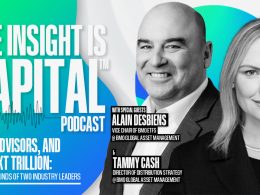by Shailesh Kshatriya, Russell Investments
On the latest edition of Market Week in Review, Director of Investment Strategies Shailesh Kshatriya and Investment Strategy Analyst BeiChen Lin discussed recent political headlines in Washington, D.C., the rise in U.S. government bond yields and the potential outcomes of Germany’s recent elections.
U.S. government shutdown averted, debt-ceiling impasse continues
The week of Sept. 27 proved to be chaotic for U.S. lawmakers, Kshatriya said, as Congress grappled with a potential government shutdown, the fate of a bipartisan infrastructure bill and a standoff over the nation’s debt ceiling. The possibility of a government shutdown was averted Sept. 30 when the House of Representatives and the Senate passed a measure to extend government funding through Dec. 3, he noted, while the other two issues remained unresolved as of midday Pacific time on Oct. 1.
“The House was originally scheduled to vote on the $1 trillion infrastructure bill—which was approved by the Senate on Aug. 10—on Sept. 30, but the vote was delayed to Oct. 1, which means that House Speaker Nancy Pelosi probably didn’t have enough votes at the time for the bill to pass,” Kshatriya stated. He explained that progressive members of the Democratic Party are threatening to withhold their support for the infrastructure bill until an agreement is reached on a broader social- and climate-spending package, which is a centerpiece of President Joe Biden’s economic agenda. The progressive and centrist wings of the party are currently at odds over the size of the proposed $3.5 trillion package, Kshatriya said, with centrist Democrats like Senator Joe Manchin of West Virginia calling for a much smaller price tag—to the tune of roughly $1.5 trillion.
“U.S. lawmakers are currently working on reconciling their differences around the size of this bill so that the House can put the infrastructure bill up for a vote—and it’s possible this vote may take place later on Oct. 1,” he stated, noting that the story bears close watching.
Another pressing issue for Congress is the impasse over the nation’s debt ceiling—or federal borrowing limit—Kshatriya said, noting that Treasury Secretary Janet Yellen recently stated that the U.S. will be at risk of defaulting on Oct. 18 if the debt limit isn’t raised or suspended by then. “A risk of default is clearly not in either political party’s best interest, so I continue to believe that the debt-ceiling standoff will be resolved by then,” he said, noting that it may take until the eleventh hour and could involve plenty of political drama.
U.S. government bond yields rise as growth outlook improves, Fed turns hawkish
Shifting gears to the recent rise in U.S. government bond yields, Kshatriya noted that the yield on the benchmark 10-year Treasury note shot up to 1.55% on Sept. 28—a dramatic rise from a week earlier, when it stood around 1.30%.
The big jump in yields can probably be attributed to three key factors, Kshatriya said, the first of which is the hawkish tone conveyed by the U.S. Federal Reserve (the Fed) after its Sept. 21-22 meeting. “At a press conference following the meeting, Chair Jerome Powell indicated that the central bank could conclude the tapering of its asset-purchasing program by mid-2022—which is a faster timeline than most had been anticipating,” he stated. This, in turn, could mean that the Fed may raise interest rates sooner than expected, Kshatriya said, explaining that investor expectations for future rate hikes are a key component of the U.S. 10-year yield.
Another factor likely helping push up yields is the recent strength in energy prices, he noted—specifically, the rise in natural gas and coal prices. “Both have spiked due to supply-and-demand imbalances across Europe and China,” Kshatriya remarked.
The third potential culprit behind the rise in yields is the improving outlook for U.S. growth, Kshatriya said, now that the surge in U.S. infections caused by the COVID-19 delta variant appears to have peaked. As the economic impacts of the surge fade, growth is likely to stabilize and improve—and this is likely playing into the rise in yields, he stated.
What is the traffic-light coalition? And how could it impact the German economy?
Turning to the outcome of Germany’s federal elections, which were held on Sept. 26, Kshatriya noted that no political party won a significant majority of the vote. In a tight contest, the Social Democratic Party (SDP) secured the highest share of votes, edging out the conservative bloc of outgoing chancellor Angela Merkel’s Christian Democratic Union and Christian Social Union (CDU-CSU), he said.
“This was a historic election, as Germany will soon have a new leader after 16 years with Merkel at the helm—but the SDP’s share of the vote is not enough for the party to lead the country without a coalition,” Kshatriya remarked. Current expectations are for the SPD, led by Olaf Scholz, to build an alliance with the country’s Green Party and its liberal Free Democratic Party (FDP). This so-called traffic-light coalition—named for the color scheme that results when each party’s representative colors are placed alongside one another—appears to be the most likely of several outcomes, he said.
For markets, the key takeaway is that if a traffic-light coalition is formed, the alliance would likely be a bit more pro-European and potentially more open to fiscal stimulus, Kshatriya remarked. “Ultimately, this would be a positive for economic growth in Germany,” he concluded.
Copyright © Russell Investments















